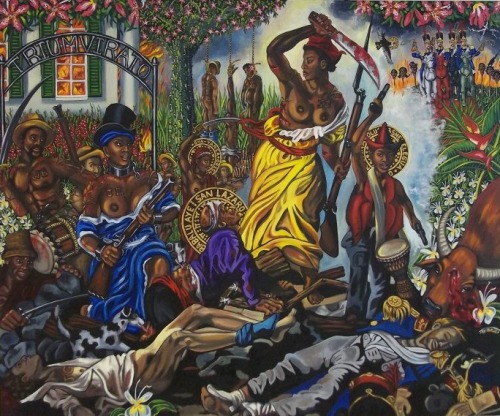#female resistance fighters
Carlota was a Lucumí-Yoruba resistance fighter who led a slave rebellion in Cuba during the mid-19th century.
Kidnapped by slavers as child, Carlota was brought from West Africa to the Matanzas province of Cuba. There she worked as a slave harvesting sugar cane on the Triumvirato sugar plantation. In response to the appalling work conditions and brutal treatment by the Spanish landlords, Carlota began to plan an uprising along with another slave woman named Fermina. However Fermina’s role in the planning was discovered by the Spanish, who had her severely beaten and imprisoned.
Despite this Carlota continued to organise the uprising. Known for both her intelligence and musical skill, she sent coded messages using talking drums to coordinate a series of attacks. As the drums were a traditional instrument among the West African slaves, the Spanish were unaware that the music was also being used a form of communication. On November 3rd 1843, Carlota led a raid which freed Fermina and a dozen other slaves from captivity. On November 5th the uprising began by at the Triumvirato and Acane sugar plantations, forcibly overthrowing the Spanish owners. These attacks were led personally by Carlota, who went into battle wielding a machete.
The uprising continued for a year during which the rebels liberated slaves from at least five large sugar plantations in the Matanzas, as well as from a number of coffee and cattle estates. While many historians have focused on the physical strength of the slaves, their rebellion also showed great sophistication, using advanced guerrilla tactics and coded communication to achieve their goals. Eventually however the forces of the Spanish Governor were able to put down the rebellion due to their overwhelming numbers.
Carlota and Fermina were both captured and executed, and 1844 became known as the ‘Year of the Lashes’ due to the tide of violence inflicted upon the slave population to bring them back into line. However Carlota’s actions created a legacy which inspired numerous subsequent rebellions against white slave owners in the Caribbean. Today there is a monument to her at the Triumvirato sugar mill.
Image credit: Carlota Leading the Slaves in Matanzas by Lili Bernard. Sourced from Atlanta Blackstar.
Post link
Hannah Szenes (1921-1944) was a Jewish Hungarian resistance fighter who was parachuted behind German lines in World War 2.
The child of a Jewish family in Hungary, Szenes showed a talent for writing from a young age. She was accepted into a Protestant private school, however in spite of a ‘gifted student’ discount she still had to pay double the regular fees because she was Jewish. Combined with her awareness of the worsening situation for Jews in Hungary, this led her to join Maccabea, a Hungarian Zionist youth movement.
In 1939 Szenes traveled to the British Mandate of Palestine where she studied agriculture and wrote poetry and plays about Kibbutz life. In 1941 she joined the Jewish paramilitary force Haganah and in 1943 volunteered to join the British Special Operations Executive to train as a paratrooper. After training in Egypt she was selected to take part in an operation to infiltrate German-occupied Europe and establish links with beleaguered Jewish communities.
On March 14th 1944 Szenes was parachuted into Yugoslavia along with two men, Yoel Palgi and Peretz Goldstein. Their mission was to enter Hungary and help save Hungarian Jews from being deported to the Auschwitzconcentration camp. The team spent 3 months working with Yugoslavian partisans, during which they discovered that Hungary had been forcibly occupied by German forces in retaliation for attempting to surrender to the Allies. Faced with this new information Palgi and Goldstein decided to call off the mission. Szenes disagreed and pressed on to the Hungarian border alone, however not long after crossing she was arrested by Hungarian police.
Szenes was imprisoned and suffered a brutal interrogation by police who wanted to know the code for the radio transmitter she used to communicate with the partisans and the British. She was stripped, tied to a chair, and whipped and clubbed for 3 days. She lost several of her teeth. Yet she refused to surrender the code and so she was transferred to a Budapest prison where she continued to be tortured. Frustrated that she wouldn’t break, the guards brought in her mother, who she had not seen for 5 years, and threatened her life. Despite this Szenes still refused to give up the code and eventually her mother was released.
Szenes spent the next three months in prison but was not idle. She communicated with other prisoners using a mirror to flash signals and used large cut-out letters to spell out messages in Hebrew. She often sang to keep up the spirits of the other prisoners. However in late October she was tried for treason and on November 7th 1944 she was executed by a German firing squad.
Following the end of the war, Szenes became widely known when her diary, poetry and plays were published. She was recognised as a national heroine of Israel and in 1950 her remains were reburied in the military cemetery on Mt HerzlinJersualem.
One of the final entries in her diary contained a poem reading:
In the month of July I shall be twenty-three,
I played a number in a game,
The dice have rolled. I have lost.
Post link
An Italian Maquis freedom fighter braves the hazardous conditions of the Alps at Little St Bernard Pass, 4th January 1945. The Italian Maquis were a resistance movement which fought against German Nazis and Italian fascists before and during World War 2. Formerly a school teacher, this woman chose to fight alongside her husband as part of the Maquis ‘White Patrol’.
Post link
Janina Forbertówna was a Polish resistance fighter who took part in the Warsaw UprisingagainstNazi occupation in 1944. Using the codename ‘Jasia’ she worked as a liaison officer in the communist partisan Armia Ludowa, or 'People’s Army’. What became of her after the failed uprising is unknown.
Post link




